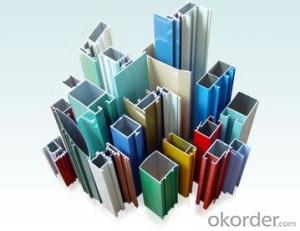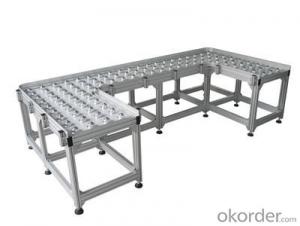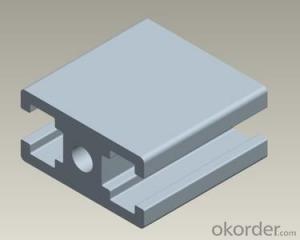Industrial aluminium extrusion profiles
- Loading Port:
- China Main Port
- Payment Terms:
- TT OR LC
- Min Order Qty:
- -
- Supply Capability:
- -
OKorder Service Pledge
OKorder Financial Service
You Might Also Like
Aluminium is a relatively soft,durable, lightweight, ductile and malleablemetal with appearance ranging from silvery to dull gray,depending on the surface roughness. It is nonmagnetic and does not easilyignite. A fresh film of aluminium serves as a good reflector (approximately92%) of visible light and an excellent reflector (as much as98%) of medium and far infrared radiation. The yield strength of pure aluminium is 7–11 MPa,while aluminium alloys have yield strengths ranging from200 MPa to 600 MPa. Aluminium has about one-third the density and stiffnessof steel. It iseasily machined,cast, drawn and extruded.
Alu Profile:
Material | Alloy 6063,6061,6005or according to customer’s choice |
Temper | T3, T4, T5, T6 |
Surface | Anodize, electrophoresis, powder coating, PVDF coating, wood grain painting, matted, etc. |
Length | Coating 6.5 meters, Anodizing 6.5 meters, Mill finish 5 meters |
Application | Industrial, electrical equipment(TV set, air conditioner, refrigerator, computer), decoration,construction, transportation |
Custom Made | We can package following with customer's request. |
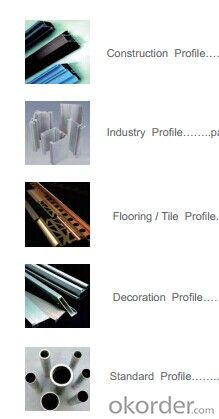
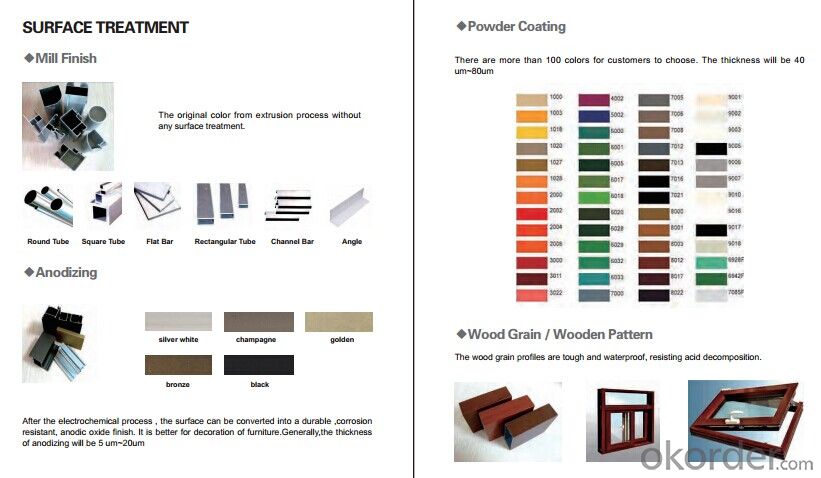

FAQ:
1. What is the form of payment?
Normally 30% TT, L/C at sight
2. Type of quotation?
FOB, CFR, CIF
3. Port of loading?
Guangzhou/Shenzhen port
4. Delivery time?
15-20 days after client’s deposit
- Q:Can aluminum profiles be used in elevator or escalator systems?
- Yes, aluminum profiles can be used in elevator or escalator systems. Aluminum is a lightweight and durable material that offers structural strength and corrosion resistance, making it suitable for various construction applications. It is commonly used in the manufacture of elevator and escalator components such as handrails, frames, panels, and supports.
- Q:Are aluminum profiles suitable for use in food processing environments?
- Aluminum profiles are well-suited for application in food processing environments. The food industry widely utilizes aluminum due to its exceptional properties. Its lightweight, durable, and corrosion-resistant nature makes it an ideal material for use in food processing, where cleanliness and hygiene are paramount. Cleaning and sanitizing aluminum profiles is a breeze, which is crucial for preventing contamination and ensuring food safety. Their smooth and non-porous surface inhibits bacterial growth and simplifies maintenance. Moreover, aluminum boasts excellent thermal conductivity, enabling efficient heat transfer and temperature control during food processing. This characteristic proves particularly valuable in food packaging, cooking, and chilling applications. In addition to its physical attributes, aluminum is non-toxic and does not react with food or beverages. As an inert material, it does not release any harmful substances that could contaminate the processed food. Overall, aluminum profiles are a reliable and suitable choice for food processing environments. They meet the industry's stringent requirements for hygiene, durability, and safety, making them a popular option in the food processing and packaging sectors.
- Q:What are the major factors determining the quality of aluminum profiles?
- Then, how to distinguish the aluminum profile is good or bad? Let's get to know those aluminum profiles that are not qualified.First, extrusion defects.Aluminum extrusion process for machine equipment is perfect, process technology is mature and whether the operation staff misconduct and other reasons, will lead to aluminum flakes, such as inclusion, delamination, chromatic aberration, distortion and other defects, affecting the quality of aluminum profiles.Second, the film thickness is thin.Industrial aluminum oxide film thickness standard should be not less than 10um (m). If the thickness is not enough, the surface of the aluminum profile is easy to rust and corrode and shorten the service life. In order to save the cost, the thickness of the oxide film is only 2 to 4um, and some even have no oxide film. It is estimated that each reduction of 1um film thickness can reduce power consumption by more than 150 yuan per ton. Thus, they can earn a lot of profits, that is why some customers say that certain companies quoted lower prices than us.Third, the chemical composition is not qualified.Some manufacturers in order to retain customers, at the incorporation of a large number of miscellaneous scrap aluminum, aluminum can greatly reduce the cost, but will lead to industrial aluminum unqualified chemical compositions, seriously endanger the life of aluminum.Fourth, reduce the wall thickness of profiles.Some manufacturers will make aluminum profile wall thickness is insufficient, originally 1.5MM thick aluminum, they in order to save costs, only 1.2MM, in this way, an aluminum prices must be cheaper. But customers do not know, but also that a good supplier found, in fact, cheated, but also to help him count the money.
- Q:What are the differences between the 6005 and 6003 aluminum profiles?Yangmingxg3
- 6003 of the magnesium content is higher than 6005, and the strengthening of magnesium to aluminum is remarkable. With the addition of 1% mg, the tensile strength increases by about 34MPa.
- Q:What are the fire safety regulations for aluminum profiles?
- Fire safety regulations for aluminum profiles vary depending on the specific jurisdiction and the intended use of the profiles. However, there are several general principles and guidelines that are commonly followed to ensure fire safety when using aluminum profiles. 1. Fire resistance ratings: Aluminum profiles are often tested for their fire resistance and assigned a fire resistance rating. This rating indicates the duration for which the profiles can withstand exposure to fire before they start to lose their structural integrity. The fire resistance rating is determined through standardized testing procedures. 2. Flame spread rating: Aluminum profiles are typically assessed for their flame spread rating, which measures the speed at which flames can spread along the surface of the profiles. A low flame spread rating indicates that the profiles have a slower flame spread rate, reducing the risk of fire spread in case of a fire incident. 3. Coating and surface treatments: The surface treatment and coating of aluminum profiles can also impact their fire safety. Certain coatings or finishes can provide additional fire resistance properties. For instance, some profiles may be treated with fire-retardant coatings that improve their fire resistance or inhibit the spread of flames. 4. Installation and use: Proper installation and use of aluminum profiles should also adhere to fire safety regulations. This may include compliance with building codes and standards, ensuring that profiles are installed in a manner that maintains their fire resistance properties, and avoiding situations that could potentially compromise the fire safety of the profiles. 5. Regular maintenance and inspections: It is important to conduct regular maintenance and inspections of aluminum profiles to ensure that they remain in compliance with fire safety regulations. This may involve checking for any damage or deterioration that could affect their fire resistance properties and taking appropriate measures to address any issues that are identified. It is crucial to consult local fire safety regulations and building codes, as well as seek guidance from relevant authorities or fire safety professionals, to ensure compliance with specific requirements for aluminum profiles in a particular jurisdiction.
- Q:Can aluminum profiles be cut to size?
- Indeed, it is possible to cut aluminum profiles to fit specific dimensions. Typically, manufacturers produce aluminum profiles in standardized lengths, which can then be readily adjusted to the desired length or size through diverse cutting techniques such as sawing, shearing, or CNC machining. As a result, aluminum profiles offer personalized options and adaptability for a variety of applications.
- Q:Can aluminum profiles be used in the construction of retail displays?
- Yes, retail displays can utilize aluminum profiles in their construction. Aluminum is a versatile and lightweight material that finds common application in various industries, such as construction and retail. It provides several benefits for retail displays, including durability, resistance to corrosion, and ease of customization. Aluminum profiles can be effortlessly shaped and fabricated to create diverse types of retail displays like shelving units, display stands, signage frames, and product showcases. These profiles can be extruded into different shapes and sizes, enabling flexibility in design and functionality. Moreover, aluminum profiles can undergo various surface treatments, such as anodizing or powder coating, to enhance their appearance and offer a protective layer against scratches and wear. This ensures that retail displays can maintain their aesthetic appeal and withstand the demands of a retail setting. Furthermore, aluminum is an eco-friendly material due to its high recyclability, making it an environmentally conscious choice for retail displays. It can be easily recycled without losing its properties, thus reducing the environmental impact of the construction and retail industries. To summarize, aluminum profiles are a practical and appropriate option for constructing retail displays. They provide durability, versatility, and customization possibilities while being lightweight and environmentally friendly.
- Q:What are the different powder coating options for aluminum profiles?
- Aluminum profiles offer a variety of powder coating options, each with its own advantages and characteristics. Let's explore the different choices: 1. Polyester powder coating: This option is both common and cost-effective for aluminum profiles. It provides great UV resistance and color retention, making it suitable for indoor and outdoor use. You can choose from a wide range of colors and finishes, including matte, glossy, and textured. 2. Epoxy powder coating: If you need strong adhesion and corrosion resistance, epoxy coatings are the way to go. They are perfect for demanding environments like marine or industrial applications. Additionally, they have good chemical resistance and are often used as a primer before applying a topcoat for extra durability. 3. Polyurethane powder coating: When durability and abrasion resistance are essential, polyurethane coatings excel. They are ideal for high-traffic areas or surfaces prone to wear and tear. With excellent color retention and gloss retention, you can expect a long-lasting finish. 4. Fluoropolymer powder coating: Known for their exceptional resistance to chemicals, UV radiation, and weathering, fluoropolymer coatings, such as PVDF (polyvinylidene fluoride), are highly durable. They provide excellent color retention, making them suitable for architectural applications where long-term performance is crucial. 5. Hybrid powder coating: If you're looking for a balanced option that combines the benefits of epoxy and polyester resins, hybrid coatings are your answer. They offer excellent adhesion and color retention, along with good weather resistance. Hybrid coatings are often used in general-purpose applications where cost-effectiveness is a priority. Remember to consider the specific requirements of your project when choosing a powder coating option for aluminum profiles. Factors like intended use, environmental conditions, and desired aesthetics will help determine the most suitable option to achieve the desired performance and appearance.
- Q:What are the advantages of industrial aluminum profiles? What are the problems that should be paid attention to?
- Among a large number of aluminum processing materials, a large number of international advanced products and national famous brand products have emerged, representing the mainstream of the development and application of modern aluminum processing technology in china.
- Q:What are the different welding options available for aluminum profiles?
- Aluminum profiles offer several welding options, each with its own advantages and considerations. The following are the most common methods used: 1. Tungsten Inert Gas (TIG) Welding: TIG welding is widely utilized for aluminum. By using a non-consumable tungsten electrode, it creates a weld while an inert gas shields the area from contamination. TIG welding provides precise control over heat input, resulting in high-quality welds. It is ideal for thin aluminum profiles, giving a clean appearance. However, it can be time-consuming and requires skilled operators. 2. Metal Inert Gas (MIG) Welding: MIG welding, also known as Gas Metal Arc Welding (GMAW), is another popular method for aluminum profiles. It involves a consumable wire electrode that continuously feeds into the weld pool, while an inert gas shield protects the area. MIG welding is faster than TIG welding and suitable for thin and thick aluminum profiles. However, it may produce more spatter and requires proper preparation and selection of shielding gas. 3. Friction Stir Welding (FSW): Friction stir welding is a solid-state joining process that utilizes a rotating tool to generate heat and mechanically stir the aluminum profiles together. FSW is particularly suitable for thick aluminum profiles, offering high joint strength, fatigue resistance, and minimal distortion. However, it necessitates specialized equipment and may not be applicable to all profile shapes. 4. Laser Beam Welding (LBW): Laser beam welding employs a highly concentrated laser beam to melt and join aluminum profiles. It creates a narrow and deep weld with minimal heat input, resulting in low distortion and high welding speeds. LBW is suitable for both thin and thick profiles, but it requires costly equipment and skilled operators. 5. Resistance Spot Welding (RSW): Resistance spot welding utilizes electrical current and pressure to create welds by melting and joining aluminum profiles at specific points. RSW is commonly used for thin aluminum profiles, providing high productivity and repeatability. However, it requires access to both sides of the profiles and may leave visible marks on the surface. To determine the most suitable welding method for your aluminum profile project, it is crucial to consider specific requirements such as profile thickness, joint type, appearance, and production volume. Seeking advice from a welding professional or engineer can ensure the best choice for your specific application.
1. Manufacturer Overview |
|
|---|---|
| Location | |
| Year Established | |
| Annual Output Value | |
| Main Markets | |
| Company Certifications | |
2. Manufacturer Certificates |
|
|---|---|
| a) Certification Name | |
| Range | |
| Reference | |
| Validity Period | |
3. Manufacturer Capability |
|
|---|---|
| a)Trade Capacity | |
| Nearest Port | |
| Export Percentage | |
| No.of Employees in Trade Department | |
| Language Spoken: | |
| b)Factory Information | |
| Factory Size: | |
| No. of Production Lines | |
| Contract Manufacturing | |
| Product Price Range | |
Send your message to us
Industrial aluminium extrusion profiles
- Loading Port:
- China Main Port
- Payment Terms:
- TT OR LC
- Min Order Qty:
- -
- Supply Capability:
- -
OKorder Service Pledge
OKorder Financial Service
Similar products
New products
Hot products
Hot Searches
Related keywords
